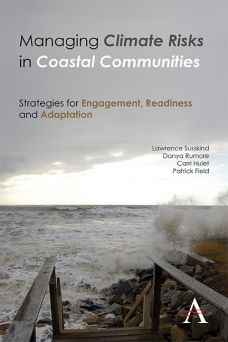Managing Climate Risks in Coastal Communities: Strategies for Engagement, Readiness and Adaptation

The challenges regarding climate change and climate change adaptation are wide and complex. Managing Climate Risks in Coastal Communities focuses on the need to address climate change risks, local climate preparedness and collective risk management. The book argues that “…it would take decades for the greenhouse gases in the global system to dissipate, even if we entirely stopped our emissions. This means that communities throughout the globe will feel the effects of climate change over the next 30 to 50 years, regardless of whether we reduce the drivers of climate change in the next decade.”
To achieve collective managing climate change risk, it is necessary to tackle communities’ risk perceptions, budgetary and political uncertainties, private property rights, persistent scepticism, and technical assessments, among other things. Thus, public officials will have to build political support to make the kinds of investments and regulatory decisions needed to reduce their community’s vulnerability and enhance its resilience. This will also require responding to changing conditions as they occur, and adaptation goals and targets almost certainly will have to be renegotiated over time.
The book describes a US project whose findings are proposed as a guide for collective risk management: the New England Climate Adaptation Project (NECAP). NECAP represented an attempt to develop and test a new approach for enhancing local readiness to engage in collective risk management. The project proceeded in collaboration with four coastal New England communities: Barnstable, Massachusetts; Cranston, Rhode Island; Dover, New Hampshire; and Wells, Maine.
The process started with assessing the social landscape through a stakeholder assessment. There were 18 to 20 interviews with key local public officials, business leaders, community activists and other stakeholders in each of the four partner municipalities. The interviews aimed to determine stakeholders’ awareness of and concern about climate change risks, as well as their thoughts about adaptation options. Interviewees were also shown climate change projections for their city or town and asked to react to those projections.
A public opinion poll was also commissioned. This was conducted by a national polling company, and randomly surveyed 100 people in each community. Poll respondents were asked a set of questions regarding their awareness of climate change, level of concern about possible local risks and thoughts about various adaptation strategies.
Additional social assessment data were collected through role-play workshops. More than 500 people completed questionnaires before and after they participated in the workshops.
The next part included a risk assessment process. The approach was divided into six key steps:
(1) Producing local-scale projections (using a statistical downscaling model, in which regional projections were used to derive local-scale estimates).
(2) Assembling data (focused on gathering information through in-person interviews with stakeholders and a review of existing data, such as previously completed assessments and reports).
(3) Integrating risks (translating local projections into meaningful terms and highlighting key risks: flooding, heatwaves, economic impacts, droughts, and related impacts on water supplies and ecosystem changes).
(4) Presenting adaptation options (grouped under four categories: (a) no action, (b) accommodation, (c) protection and (d) retreat).
(5) Communicating findings through reports (providing a context-specific and image-rich product).
(6) Engaging the community (including stakeholder assessment interviews and risk dialogues, as well as findings within role-play workshops and final debriefing workshops in each community).
In conclusion, Managing Climate Risks in Coastal Communities suggests that it is necessary to consider certain objectives that can help to achieve some real action regarding climate change adaptation:
(1) Generate usable knowledge (focus on producing knowledge that is salient, credible and legitimate; gather stakeholder and expert knowledge).
(2) Cultivate community literacy about risks and responses (make climate-related risks tangible and relevant; focus on local impacts; make the case for local collective action; generate community dialogue about risks and responses; foster shared learning).
(3) Increase optimism about collective risk management (show pathways forward; focus on actionable solutions; frame the problem in ways that create widespread buy-in for solutions; engage decision-makers and the public in dialogue).
(4) Enhance community collaborative capacity (show the importance of collective risk management; model collaborative problem-solving; foster consideration of other perspectives and empathy; and create forums for ongoing public learning and engagement).
Book note prepared by Dora Catalina Suárez
Search the Book notes database
Our Book notes database contains details and summaries of all the publications included in Book notes since 1993 - with details on how to obtain/download.
Use the search form above, or visit the Book notes landing page for more options and latest content.
For a searchable database for papers in Environment and Urbanization, go to http://eau.sagepub.com/

